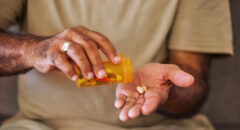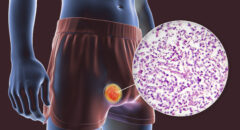
Condoms are one type of birth control that not only prevents pregnancy, but also can help prevent the spread of sexually transmitted diseases (STDs). But, there are many facts about condoms that can cause confusion, potentially limiting their effectiveness.
What types of condoms are there?
There are two types of condoms, the male condom and the female condom.
Most condoms are made of a type of rubber called "latex." Latex condoms are the most effective condom at preventing STDs. Recently, condoms made of polyurethane (a type of plastic) have become available. These are more expensive than latex condoms and seem to break more easily. They are mainly useful for people who are allergic to latex. There are also "natural" condoms, which are made of animal membranes (lambskin). These are expensive and although they are effective at preventing pregnancy, they do not decrease the spread of many sexually transmitted diseases.
The female condom is a lubricated polyurethane (plastic) tube that has a flexible ring at each end. One end of the tube is closed.
What are the most important things to consider when buying condoms?
Both male and female condoms can be purchased at most drug stores, in addition to being available at clinics, as well as other locations. When choosing a condom, here are some things to should keep in mind:
- Size. One size does NOT fit all. While the standard size will fit most men, extra-large condoms are available, as well as "snug" sizes that are a little smaller and fit tighter than the standard size.
- Shape. Some condoms come with a nipple in the end to hold the fluid when the man ejaculates. Others have a rounded end. Either way, both size
- Thickness. Extra-strength condoms are available. These are stronger and are especially useful for rectal sex and for men who have problems with condom breakage. Extra thin condoms also are available, but these are not recommended because they may break more easily.
- Lubrication. Many condoms come pre-lubricated. This lubrication can be a substance that kills sperm (spermicide) and many disease-causing germs. Lubrication may give some extra protection in preventing pregnancy, especially if the condom breaks. Lubricated condoms taste bad and are not recommended for oral sex.
4 Biggest Condom Mistakes:
1. Double Bagging Doesn't Work.
Using two condoms will not give you double protection, and neither will using a male condom with a female condom. All this will do is make them more likely to tear, which would actually put you at increased risk of infection and pregnancy. Don't worry, one is enough. If your condom does break or slip off and you're worried about pregnancy, you can get the morning-after pill.
2. How You Take Off The Condom Matters Too
Most men lose their erection pretty quickly after they ejaculate, says Kerner. So you'll want to take the condom off before you go soft, since that could mean a lot more room in your condom and more opportunities for semen to spill out or the condom to slip off.
When taking off the condom, hold the rim as you pull it off to prevent any spillage. Bonus points for tying the end in a knot before you toss it in the trash.
3. Read The Label
Who reads the labels on condoms? Well, you should start. Yes, condoms expire. Even though some last for a few years, other condoms with added lubricants or spermicide have a shorter shelf life. So be sure to look it up before you wrap it up.
4. Keep It On (the whole time)
In order for condoms to work their magic, they need to be worn for the entire duration of the sex, even if you're...
... also using another method of birth control. In one recent study, only 59% of people who used condoms with another birth control actually kept the rubber on the whole time. (The rest of them put it on after some genital contact or took it off before they finished.) Because any skin-to-skin genital contact can lead to STIs, it's important to keep it on from beginning to end.
What condom habits to I need to keep in mind?
Condoms should be used any time a man's penis is inserted into the body of another person, particularly if there is even the slightest risk that either person has an STD. Men frequently become infected with STDs when receiving oral sex, so ideally, a condom should be worn then, too.
The condom should be put on before there is any contact, and should be removed and thrown away promptly after the man has ejaculated.
Other facts to keep in mind include:
- Be careful when opening the wrapper to avoid tearing the condom with your teeth, fingernails, or rings.
- Gently pinch the air out of the tip of the condom before putting it on.
- The condom is rolled over the erect penis before sexual activity begins, and must be in place before the penis gets near the vagina.
- Be sure to keep your condoms out of your pocket or wallet. Warming condoms decrease their effectiveness and increase their chance of breakage.
- If the condom does not have a built-in nipple, leave about 1/2-inch of the condom free at the tip of the penis so that semen has a place to collect.
- A new condom must be used each time you have sex.
- If you use lubricants with a condom, be sure to only use water-based lubricants, such as K-Y Jelly. Oil-based lubricants, such as Vaseline, massage oils, and body lotions can cause condoms to leak or break.
- Certain vaginal medications used to treat yeast infections can also weaken condoms.
How do you use female condoms?
Before sexual activity begins, the woman inserts the condom into her vagina so that the closed end of the tube covers the cervix, and the other end slightly covers the labia (lips on the outside of the vagina). The condom blocks sperm from entering the womb. Female condoms should be discarded after one use.
What about spermicidal lubricants?
Initially it was felt that condoms lubricated with spermicidal agents offered more protection against STDs. Newer studies show that frequent use of condoms containing spermicides offers no additional protection and it may actually increase the risk of HIV and other STDs by irritating the vagina and penis. Spermicidal products do however remain useful in pregnancy prevention.
How can I prevent the condom from breaking?
A condom can easily break when:
- It's too old. Modern condom wrappers have a date after which the condom should not be used.
- It hasn't been stored properly. Heat damages latex condoms, so they should not be kept in a hot place, such as a car glove compartment or wallet.
- There's not enough lubrication during sex. Additional lubrication is always needed for rectal sex. It may also be needed for vaginal sex. The lubricant should be water-soluble, such as KY jelly.
- The wrong type of lubricant is being used. Lubricants that contain oil -- such as Vaseline, baby oils, and vegetable oils -- should not be used with latex condoms since they weaken the material.
- It's too small. If necessary, buy a larger-sized condom.
- Your partner is too tight. In this situation, use an extra strength condom and more lubricant.
How can I prevent the condom from slipping off during sex?
A condom may come off during sex because:
- It's too large. Try a snug condom.
- Loss of erection. Remove your penis, holding on to the rolled edge of the condom, as soon as you begin to lose your erection.
How effective are condoms at preventing pregnancies?
Male condoms are about 85% effective for birth control. When used together and properly, spermicidal foam and condoms are about 97% effective in preventing pregnancy. The female condom is about 75% effective.
How much protection from STDs do condoms really offer?
Latex condoms provide protection from sexually transmitted diseases by preventing the infected area from coming into contact with the partner. Latex condoms provide the best amout of protection, although polyurethane condoms do provide some protection, although not as much.
Natural or lambskin condoms do not protect against STDs, since they have larger holes or "pores" that allow the small particles that can cause some STDs to pass through.
Female condoms provide some protection against sexually transmitted diseases, but the male condom provides the best protection if you have sex. Female condoms should not be used in combination with male condoms. The friction of the two could result in product failure.









